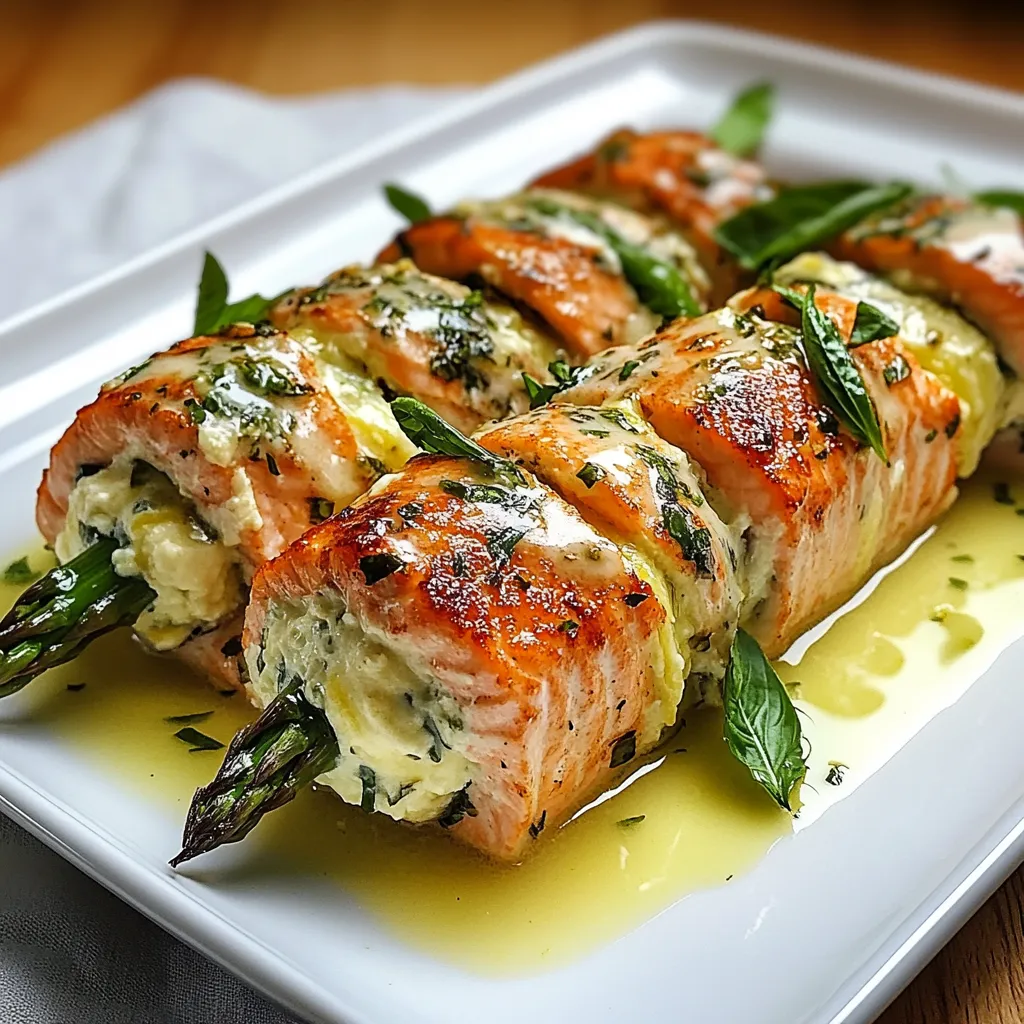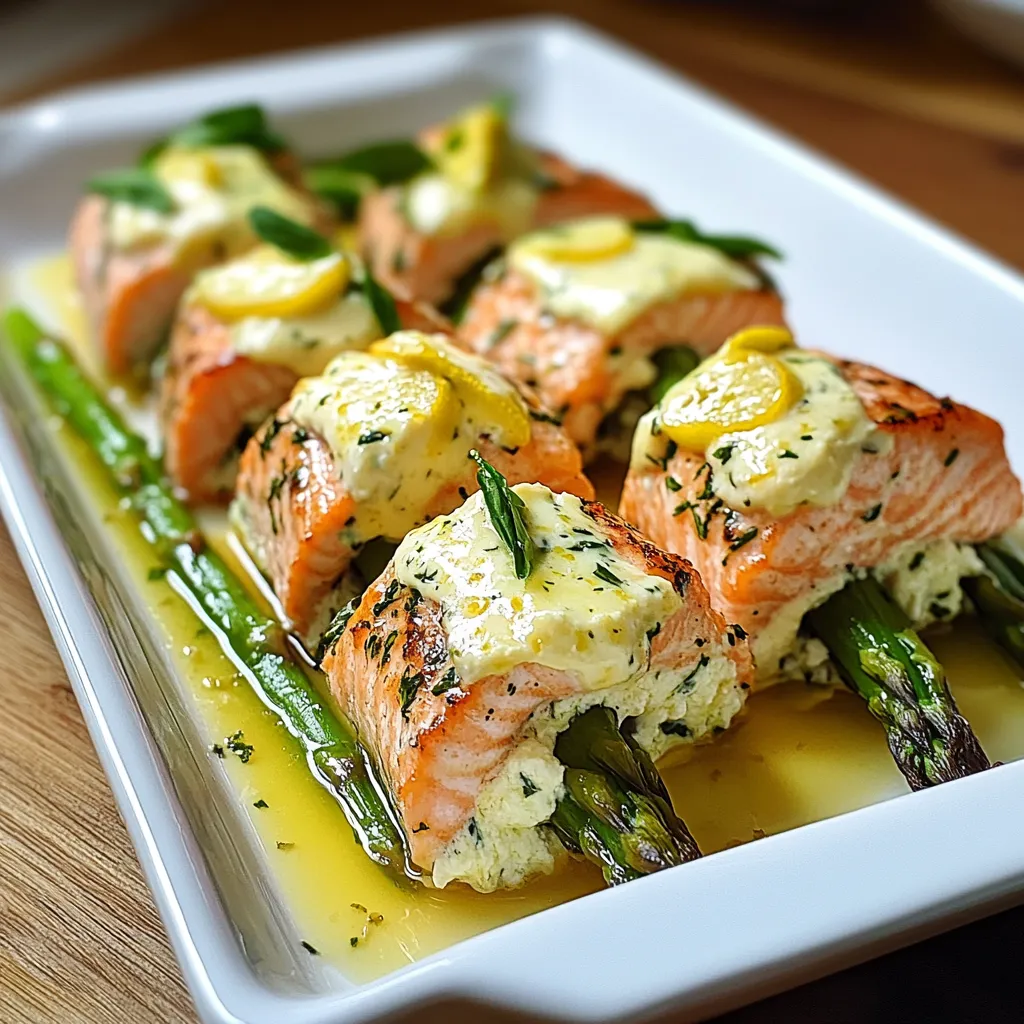 Pin it
Pin it
This elegant asparagus and lemon basil ricotta stuffed salmon roll recipe transforms everyday salmon into a restaurant-worthy dish without complicated techniques. The bright lemon sauce ties everything together, making a meal that looks impressive but comes together with straightforward steps anyone can master.
I first created this recipe when hosting a small dinner party where I wanted something elegant but not overly fussy. The combination of the bright lemon, creamy ricotta, and tender salmon has since become my go-to impressive yet approachable meal for special occasions.
Ingredients
- Boneless skinless salmon filets: Sliced lengthwise makes for easier rolling and even cooking
- Asparagus spears: Choose medium thickness spears for the best texture inside the rolls
- Ricotta cheese: Provides creamy texture and mild flavor that carries the herbs and lemon
- Fresh lemon zest and juice: Essential for bright flavor throughout every component
- Fresh basil: Adds aromatic notes that complement both the salmon and the asparagus
- Garlic: Provides savory depth to both the filling and sauce
- Fish or vegetable stock: Creates a flavorful base for the silky lemon sauce
- Cream: Optional but adds a luxurious texture to the final sauce
Step-by-Step Instructions
- Prepare the Ricotta Filling:
- Combine the ricotta with lemon zest, juice, basil, minced garlic, parmesan, salt, and pepper in a medium bowl. Mix thoroughly until completely incorporated and the texture is smooth and spreadable. The filling should be well seasoned but not overpowering since it will be inside the delicate salmon.
- Blanch the Asparagus:
- Start with well salted boiling water about as salty as pasta water. The asparagus only needs about 2 minutes until it turns vibrant green but still has a nice snap. Immediately stopping the cooking process with cold water is crucial to maintain the perfect texture. Thoroughly pat the spears dry to prevent making the salmon rolls soggy.
- Prepare the Salmon:
- Working with room temperature salmon makes it more pliable for rolling. When flattening, use gentle pressure to create an even thickness of about half an inch without tearing the delicate flesh. Season both sides lightly with salt and pepper, keeping in mind the filling is already seasoned.
- Fill and Roll the Salmon:
- Spread the ricotta filling in an even layer about a quarter inch thick leaving a small border around the edges. Position asparagus spears parallel to the long edge of the salmon. Start rolling from the narrow end, using gentle but firm pressure to create a compact roll without squeezing out the filling. Secure with toothpicks by inserting them at an angle for easier removal later.
- Sear and Bake:
- Heat a heavy skillet until quite hot before adding oil to prevent sticking. Carefully place the salmon rolls seam side down first to seal them closed. The initial sear creates a beautiful golden crust and helps lock in moisture. Transferring to the oven allows for gentle, even cooking throughout without drying out the exterior.
- Prepare the Lemon Sauce:
- The key to a smooth sauce is creating a proper roux first by cooking the flour with fat until it smells slightly nutty but not brown. When adding stock, pour slowly while constantly whisking to prevent lumps. The sauce should coat the back of a spoon but still flow easily. If it becomes too thick, add a splash more stock.
- Plate and Garnish:
- Remove kitchen twine or toothpicks carefully before serving. Spoon the warm sauce onto warmed plates first, then place salmon rolls on top. The fresh herbs add both color and an extra layer of flavor that brightens the entire dish.
 Pin it
Pin it
This recipe reminds me of spring evenings in my grandmother's garden where we would harvest the first asparagus of the season. She taught me that the combination of lemon and herbs can transform simple ingredients into something truly special. The memory of her delight when I first made these salmon rolls for her makes this dish particularly meaningful to me.
Make Ahead Tips
For effortless entertaining, prepare the ricotta filling and blanch the asparagus up to 24 hours in advance. Store separately in airtight containers in the refrigerator. The salmon can be rolled and assembled up to 4 hours before cooking, but avoid doing this too far in advance as the acidity in the lemon can begin to "cook" the raw salmon if left too long.
Perfect Pairings
These elegant salmon rolls pair beautifully with simple sides that complement without competing. A light spring risotto with peas makes an excellent accompaniment, as does a simple arugula salad dressed with lemon vinaigrette. For a more substantial meal, serve alongside roasted fingerling potatoes tossed with herbs and olive oil.
Troubleshooting Tips
If your salmon is difficult to roll, try placing it between sheets of plastic wrap and gently flattening it more with a rolling pin. Should the filling seem too loose, refrigerate it for 20 minutes before spreading onto the salmon. For a thicker sauce, allow it to simmer a minute or two longer, and for a thinner consistency, add a splash more stock until you reach your desired texture.
Ingredient Substitutions
No fresh basil available? Substitute with dill or tarragon for equally delicious results. Mascarpone cheese can replace ricotta for a richer filling, while dairy free cream cheese works for lactose sensitive diners. If asparagus is out of season, try blanched green beans or julienned zucchini strips instead. The recipe adapts beautifully to what you have on hand.
 Pin it
Pin it
With these simple steps and tips, you’ll have an elegant dish that’s as delicious as it is memorable.
Frequently Asked Questions
- → Can I prepare these salmon rolls ahead of time?
Yes, you can assemble the salmon rolls up to 4 hours ahead and refrigerate them covered. Just bring them to room temperature for 15 minutes before cooking. The sauce is best made fresh just before serving.
- → What sides pair well with these salmon rolls?
These salmon rolls pair beautifully with steamed rice, roasted potatoes, or orzo pasta. For vegetables, try a simple green salad, roasted Brussels sprouts, or sautéed spinach to complement the richness of the dish.
- → Can I use frozen salmon for this dish?
Yes, but make sure to thaw it completely and pat it very dry before using. Frozen salmon often releases more moisture during cooking, so you may need to sear it slightly longer to achieve the same golden crust.
- → How do I know when the salmon rolls are fully cooked?
The salmon rolls should reach an internal temperature of 135-140°F (57-60°C). The flesh should be opaque and flake easily with a fork. Since the rolls are stuffed, it's best to use a thermometer to ensure they're properly cooked without drying out.
- → Can I substitute the ricotta cheese with something else?
Absolutely. Cream cheese makes an excellent substitute, though it's richer. Goat cheese offers a tangier flavor profile that works well with the lemon. For a lighter option, you could use a thick Greek yogurt mixed with a bit of mayo for creaminess.
- → What can I use instead of asparagus?
Green beans, thin zucchini spears, julienned bell peppers, or even thinly sliced leeks make good alternatives to asparagus while maintaining the structure needed for rolling.
